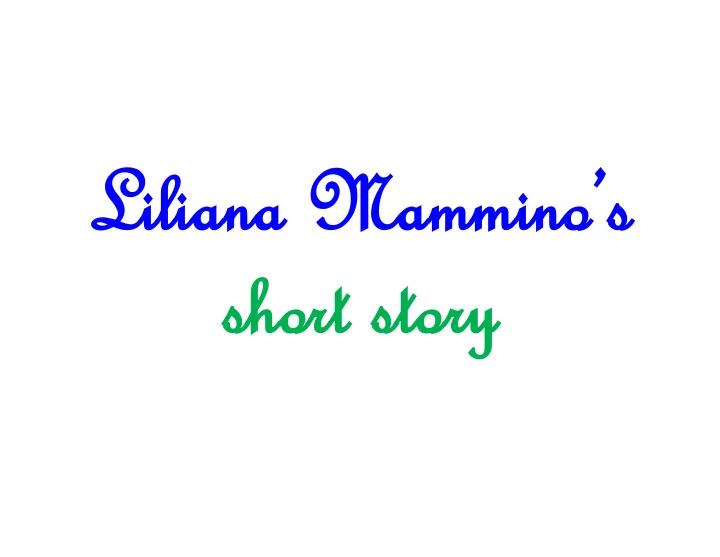

Lilia Liliana Ma na Mammino mmino ’s short story short story
SURNAME Mammino FIRST NAME Liliana WHERE I AM FROM Italy CURRENT POSITION Professor emeritus Department of Chemistry University of Venda (UNIVEN) South Africa AREA OF SPECIALISATION theoretical/computational chemistry other interest : chemistry education
EDUCATION Ph.D. in chemistry Moscow State University (Russia), 1982 Degree in chemistry University of Pisa (Italy), 1973 A 5-year degree Classical Lyceum Diploma Liceo-Ginnasio A. Canova, Treviso (Italy) (humanities-oriented secondary education)
WORK HISTORY SUMMARY National University of Somalia, 1974 1975 University of Zambia, 1988 1992 National University of Lesotho, 1993 1996 At UNIVEN since 1997. Another activity Research for the preparation of a chemistry textbook and textbook writing, 1983 1993.
BUILDING COMPUTATIONAL CHEMISTRY RESEARCH AT UNIVEN Built de novo , starting in 2004. still ongoing process. Overview of research themes (computational study of...) acylphloroglucinols antimalarial alkaloids of plant origin magnetically-induced currents through chemical bonds muchimangins sulphonylureas
Computational approaches methods : in vacuo : HF, MP2 (or MP2/HF), DFT/B3LYP bases 6-31G(d,p) 6-31+G(d,p) in solution: PCM (polarizable continuum model) calculation software : GAUSSIAN 03 visualization : GaussView, Chem3D equipment : desk-top PCs
ACYLPHLOROGLUCINOLS (ACPLs) A large class of compounds structurally derived from 1,3,5-trihydroxybenzene (phloroglucinol) and characterised by the presence of a COR group Many of them are of natural origin R O 14 and exhibit a variety of biological C 7 H 15 activities : bactericide, antibiotic, O 12 1 O 8 fungicide, antioxidant, antimalarial, H 17 6 2 etc. 5 3 4 R' Viewed as potential lead compounds for drug development O 10 H 16
What has been done Conformational studies monomeric ACPLs as a class of compounds [1 5] dimeric ACPLs as a class of compounds [6] Study of solvent effects PCM studies in chloroform, acetonitrile and water [7] study of adducts with explicit water molecules [8] Study of individual ACPL molecules ACPLs with specific biological activities: antitubercu- losis [1, 9, 10], anticancer [11, 12], antioxidant [13 18] other ACPL molecules [19, 20] Study of supramolecular structures [21] Complementary studies: the parent compound [22], its acid [23] and hydroxybenzenes in general [24, 25].
Patterns for the intramolecular hydrogen bond and the orientation of the OH groups in ACPLs d-r d-w s-r s-w d-r-u d-w-u s-r-u s-w-u r w
lowest energy conformers of selected structures A-d-r B-d-r D-d-r-1 E1-d-r-1 F1-d-r-1 G1-d-r-1 L-d-r N-d-r W-d-r-1 B-ET6-d-r D-KT5-d-r B-Y3B5-d-r-q2 caespitate
structures with additional O H O IHBs donor or acceptor in R donor or acceptor in R
Other IHB types Interaction of an OH with a system C H O interactions
Adducts with explicit water molecules adducts with one water molecule attached in turn to different donor or acceptor sites via an intermolecular H- bond, whose energy is calculated: 6 8 kcal/mol when H 2 O is the acceptor 3 5 kcal/mol when H 2 O is the donor adducts with enough water molecules to approximate the first solvation layer interaction energy between the central molecule and the water molecules: 30 33 kcal/mol when R = CH 3 38 40 kcal/mol when R = H
Adducts with explicit water molecules
Study of antioxidant ACPLs Calculated complexes with a Cu 2+ ion to test their reducing ability Considering all the possible binding sites for the ion The charge of the ion is always reduced Complexes of antioxidant ACPLs with a Cu 2+ ion
Dimeric acylphloroglucinols abbreviatin AB bis(2,4-diacetylphloroglucyl) methane antibiotic, antimalarial
Bowl-shaped structures ( potential ) interesting feature : particularly deep bowls
ANTIMALARIAL ALKALOIDS OF PLANT ORIGIN postgraduate student Kabuyi Mireille Bilonda (DRC) pyrazole alkaloids [26] A: withasomnine, B: p-hydroxy derivative of withasomnine, D: p-methoxy derivative of withasomnine, E: newbouldine, F: p-hydroxy derivative of newbouldine, G: p-methoxy derivative of newbouldine
Naphthylisoquinoline alkaloids monomeric structures [27]
dimeric structures [28 30] Josemine A 2 Michellamine A anti-HIV antimalarial
intramolecular hydrogen bond in quinine quin-1- cis quin-1- trans quin-2- cis quin-1- trans quin-3- cis quin-3- trans first realization of the possibility of an IHB in the quinine molecule [31]
MUCHIMANGINS muchimangin B is active against pancreatic cancer, the others are not B A C D calculated both actual and model structures [32, 33] dominant importance of IHB patterns importance of moieties’ orientations
MAGNETICALLY INDUCED CURRENTS THROUGH CHEMICAL BONDS collaboration with Prof Luis Alvarez Thon Aromaticity and IHBs in hydroxybenzenes Isosurface of the magnitude of the current density (isovalue = 0.005) [34]
Current through the bond in diatomic molecules [35] H 2 Cl 2 HCl NaCl N 2
MY GROUP Size of the group two M.Sc. students one Ph.D. student myself Possibilities of further expansion attracting more postgraduate students challenge: many students consider this research area as too difficult
An interesting feature the way research was developed can be viewed as a possible model for capacity building in computational chemistry research in institutions in which it is not yet present [36, 37] the area is still scarce-skills in many contexts importance to share existing expertise : for research capacity building, including under challenging conditions for education and training training trainers
WHAT I WOULD LIKE SEEING HAPPENING General features developing this research where it is not yet present fostering other specialists’ familiarisation with its core activities and consequent collaboration possibilities exploration of new options, including sustainability increasing general familiarisation with the theoretical background of chemistry networking “ sharing ” of available specialists where useful and feasible conduction of parallel projects in different institution/countries, above all in the initialisation stage
A suggestion developing the computational study of antimalarial molecules of natural origin in several countries simultaneously and co-ordinately envisaged advantages : generation of information useful to drug development retaining relevant stages of it in the continent connection with an issue ( malaria ) that is an actual and urgent problem in many African countries contributing to highlight the relevant roles of computational chemistry research for other types of research and for the search aimed at addressing health problems connection with indigenous knowledge system
thank you merci obrigada
Recommend
More recommend